Jenolan Caves
Grand Arch
Useful Information
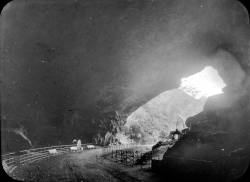
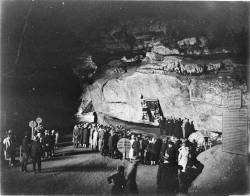
| Location: |
4655 Jenolan Caves Road, Jenolan Caves NSW 2790.
182 km west of Sydney. (-33.8194780, 150.0222708) |
| Open: |
no restrictions. [2023] |
| Fee: |
free. [2023] |
| Classification: |
 Karst Cave Karst Cave
 Natural Bridge Natural Bridge
 Caves Used as Road Tunnels Caves Used as Road Tunnels
|
| Light: | not necessary |
| Dimension: | L=127 m, W=55 m, H=24 m. |
| Guided tours: | self guided. |
| Photography: | allowed |
| Accessibility: | yes |
| Bibliography: | |
| Address: |
Jenolan Caves, 4655 Jenolan Caves Road, Jenolan Caves NSW 2790, Tel: +61-2-6359-3911, Tel: 1300-76-33-11.
E-mail: |
| As far as we know this information was accurate when it was published (see years in brackets), but may have changed since then. Please check rates and details directly with the companies in question if you need more recent info. |
|
History
| 1838 | discovered. |
| 23-FEB-1929 | unveiling of a plaque to commemorate the 50th anniversary of Jeremiah Wilson’s discovery of the Imperial Cave. |
Description
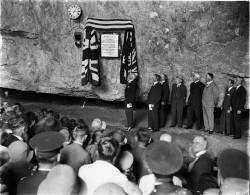
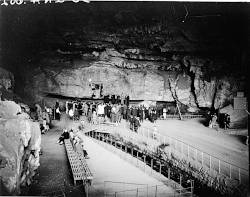
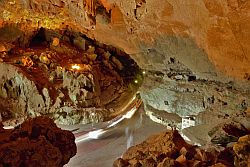
The cave system of Jenolan has a natural meeting place or base camp, the impressive Grand Arch. Here is the start of most cave tours which lead into the various branches of the cave system. It is a main passage, huge enough for a road and for concerts, but it is also only a cave ruin, as only some 130 m of this passage still exist. The rest has collapsed and forms now a valley, where the Cave Lodge is located.
The Grand Arch is one of only half a dozen caves on Earth with a road built through. This road connects the town Oberon with the Great Western Highway A32 and is called Jenolan Caves Road, as it is actually only for the visitors of the cave. The winding and narrow road is 80 km long, but at least it is paved. On the western side is the Jenolan Caves House, on the eastern side is the beautiful Blue Lake.
The arch is frequented by visitors on their way to the cave tour, it is used by vehicles and pedestrians. Pedestrians are advised to be careful in the narrow parts, where they have to walk on the road. There are benches if you have to wait, and there is one of the extremely rare cave toilets! The builders were quite consequent: while the toilet has walls, doors, and all the infrastructure you expect, it has no roof. So you can have a nice look at the cave ceiling 20 m above while you’re at it.
Several show caves start inside the arch or very close to it, it is more or less a min artery in the complex cave system. For obvious reasons show caves were built into branches starting from the arch.
The wall on the right side of the road coming from the Blue Lake side has a tarnished plaque, commemorating Jenolan’s early cave explorers. It was inaugurated in 23-FEB-1929, several pictures on this page depict this event. The elderly man unveiling the plaque was one of the great Aussie heroes of the era, Sir Tannatt William Edgeworth David. Edgeworth David, was born in 1858 in Wales and went to Oxford University, to study geology. In 1882, he was hired by the NSW government to be the new assistant geological surveyor, replacing Lamont H. Young, who had disappeared under mysterious circumstances – possibly murdered on the goldfields. He worked hard and in the same year he had completed a geological sketch map of the Yass district. While doing a geological survey of the Hunter coal fields in 1886, he discovered the Greta Coal Seam. This seam yielded over £50 million worth of coal up to 1949 and employed tens of thousands of people in over 30 collieries.
In 1888, he visited Jenolan for the first time, at the first meeting of the Australasian Association for the Advancement of Science. He presented three papers and helped lead a four-day excursion to Jenolan Caves. Then he began public lecturing, became Chair of Geology and Palaeontology at the University of Sydney, and Professor of Geology in 1891. It seems his lectures were fascinating, as he was famously popular with his students. One of his first innovations was the introduction of field trips, today quite common but an unconventional idea at the time. Even more radical, he encouraged Australian women to become geologists and palaeontologists.
In 1907, he was invited to join Ernest Shackleton’s Antarctic Nimrod Expedition. He was nearly 50 years old, at the first-time ascent of Mount Erebus, the only active volcano in Antarctica. Then he set off for the Magnetic South Pole, which he reached on 16-JAN-1909. Before he had been famous among geologists and students, but now he was known by every Australian. In World War I he used his knowledge to assist in military mining and tunnelling. 1918, he was awarded the Distinguished Service Order and was promoted to lieutenant colonel. Two years later he was knighted and became known as Sir Edgeworth.
When he returned to Jenolan in 1922 and became show cave guide. He arrived in the January school holidays, and there was a massive need of additional guides. So he volunteered himself and two of his students, and they were in constant demand, and guided hundreds of visitors through the cave. He later did the same on other occasions. He also regularly brought scientific events, like the Pan Pacific Science Congress, to Jenolan. The formerly mentioned plaque was commemorating the 50th anniversary of Jeremiah Wilson’s discovery of the Imperial Cave. The irony is, that most likely Lamond Young and Henry Cambridge discovered the Imperial Cave one year earlier. Lamond Young was already mentioned, he was the assistant geological surveyor Edgeworth David replaced when he came to Australia. It’s always the same: It’s not enough to discover things, you also have to publish them.
At one point the arch is 50 m wide, so it also offers enough space for concerts and other events. During the last years the ABBA tribute band ABBAs BACK performed several times here. Concertgoers are advised to dress warmly and bring a folding chair.
 Search DuckDuckGo for "Grand Arch Jenolan"
Search DuckDuckGo for "Grand Arch Jenolan" Google Earth Placemark
Google Earth Placemark Grand Arch Cave at night, Jenolan Caves, New South Wales, Australia (visited: 14-JUN-2019)
Grand Arch Cave at night, Jenolan Caves, New South Wales, Australia (visited: 14-JUN-2019) Index
Index Hierarchical
Hierarchical Countries
Countries Maps
Maps